November (Kartik-Margsheersha)
Sharad Purnima

The Sharad Purnima or Kojaagari Purnima or Kumar Purnima is a harvest festival celebrated on the full moon day of the Hindu lunar month of Ashvin (September–October). It marks the end of monsoon. There is a traditional celebration of the moon and is also called the ‘Kaumudi celebration’, Kaumudi meaning moonlight. It is also believed that on this day as moon and the earth are very close to each other, the moon rays have certain healing properties of nourishing the body and the soul.According to Srimad Bhagvad Purana, the famous Raas Lila of Lord Krishna with Radha and Gopis took place on the night of Sharad Poornima.
The Sharad Poornima night the moon is close to the earth on the day and due to this the rays of the moon has several curative properties.Sharad Purnima is celebrated on Ashwin Purnima falling during night. If Ashwin Purnima falls on two days and falls or does not fall during night then it is celebrated on second day.
In some regions, Poha, puffed rice, and kheer, sweet, is prepared and left in the moonlight and is consumed later. In some areas, the full moon is not seen directly instead it seen on a vessel filled with boiling milk..
This fast is observed on the Poornima of bright half of Hindi month Ashwin. After having bath worship your family God by performing Shodashopchar Puja.. At night mix sugar in the milk of cow and keep it under the rays of Moon. Offer it to your favourite God and Laxmi and serve among devotees. Chant Bhajans in the night.
Karwa Chauth Vrat
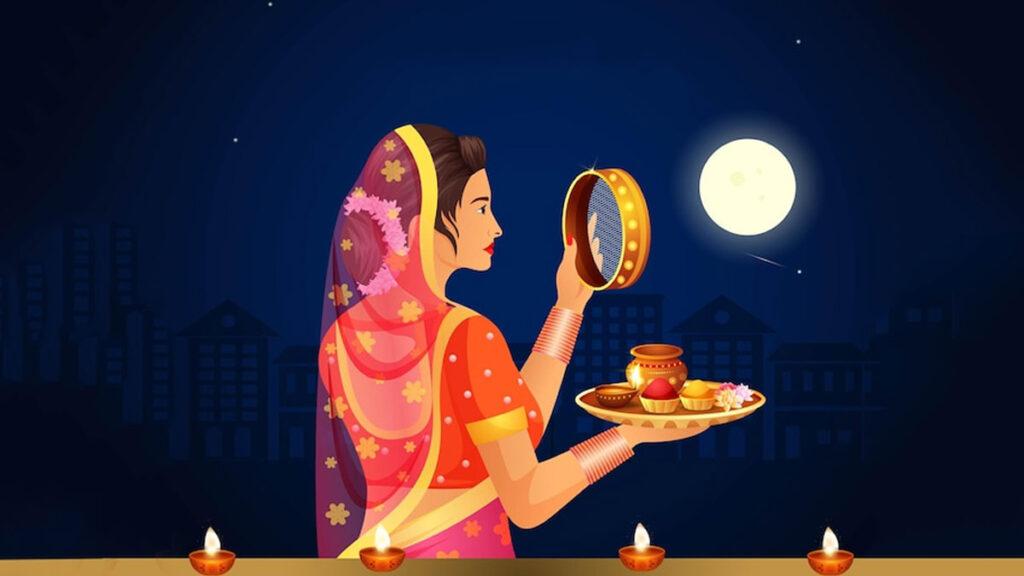
The name Karwa Chauth is formed of two words ‘Karwa’ and ‘Chauth’, where Karwa means earthen oil lamp and Chauth means four. The day falls on the fourth day of Kartik month in Hindu calendar.. This festival also coincides with Diwali celebration, which comes nine days after Karwa Chauth. Although Karwa Chauth was initially celebrated as special bond shared between bride and a woman in her in-laws household, gradually new aspect of celebration emerged out of this ancient custom. Today, it is observed more as an occasion to seek blessings from almighty for the long life and overall well being of one’s husband. Even though the original custom of celebrating Karwa Chauth has greatly changed from what it used to be in the past, it still holds relevance to present day meaning of observing fast for the well-being of a husband. Karwa Chauth is celebrated with great pomp and is considered as a very auspicious occasion for women—both married and committed. This festival reinforces the bond of love between husband-wife duos and hence, is special for every married individual.
Karva Chauth is celebrated on Kartik Krishna Chaturthi falling at Chandrodaya (rise of Moon). If Chaturthi falls on two days but does not fall during Chandrodaya then it is celebrated on second day otherwise on the first day.The Karva Chauth fast is unique perhaps because nowhere in the world does a wife go without food or water just to pray for the longevity and well-being of her husband.In modern day, with all the trappings of commercialization attached, Karva Chauth, the big fasting day has turned into a full-fledged eventKarva Chauth special eateries are gearing up for now. Cashing in on the popularity of ‘eating out’ most restaurants have special menus for this special day.
Ahoi Ashtami Vrat

Celebrated in autumn on the Ashtami day, the Ahoi festival or Ahoi Ashtami is a fast observed by mothers for the well-being of their sons. The Ahoi Ashtami is usually celebrated in the months of October-November or the Karthik month (specifically the 8th day after full moon) in the Hindu calendar. Very similar to Karwa Chauth, although not as popular, the Ahoi Ashtami is performed mostly by people living in the North of India.
For the long life of children Ahoi Ashtami is celebrated on Kartik Krishna Ashtami falling at Pradosh (evening). If Kartik Krishna Ashtami falls on two days but falls or does not fall at Pradoshkaal then it is celebrated on Second day otherwise first day.
The Ahoi Ashtami fast and prayer are almost similar to that of Karwa Chauth. People from different parts of North India celebrate the fast with a few variations. But broadly the following method is followed to observe the fast and prayer.
Mothers fast all day and offer prayers to Ahoi Mata. They wake up before sunrise, have some refreshments and proceed to the temple to offer prayers for their children. The fast ends in the evening when the moon appears. Some families also break their fast once they see the stars in the sky.
The picture of Ahoi Mata is painted on a wall and a bowl of water is placed on it. Printed calendars, posters and pictures of Ahoi Mata are now available and can be used in place of the wall painting.
Dhan Trayodashi

Dhanteras is the first day of the five-day Diwali Festival as celebrated in India. The festival, known as “Dhanatrayodashi” or “Dhanvantari Trayodashi”.The word Dhan means wealth and Teras means 13th day as per Hindu calendar. It is celebrated on the thirteenth lunar day of Krishna paksha (dark fortnight) in the Hindu calendar month of Kartik.
On Dhanteras, Goddess Lakshmi is worshiped to provide prosperity and well-being. Dhanteras holds special significance for the business community due to the customary purchases of precious metals on this day. Lord Kubera, the God of assets and wealth is also worshipped on this day.
An ancient legend ascribes the occasion to on interesting story about the 16 year old son of King Hima. It is also known as ‘Yamadeepdaan’ as the ladies of the house light earthen lamps or ‘deep’ and these are kept burning throughout the night glorifying Yama, the God of Death. Since this is the night before Diwali, it is also called ‘Chhoti Diwali’ or Diwali minor Diwali.According to another popular legend, when the Gods and demons churned the ocean for Amrita or nectar, Dhanvantari (the physician of the Gods and an incarnation of Vishnu) emerged carrying a jar of the elixir on the day of Dhanteras.
Dhan Trayodashi (Dhan Teras) is celebrated on Kartik Krishna Trayodashi falling at Pradosh. If Kartik Krishna Trayodashi falls on two days and falls or does not fall at Pradosh then it is celebrated on second day otherwise on first day. On Dhanteras Hindus consider it auspicious to purchase gold or silver articles or at least one or two new utensils. It is believed that new “Dhan” or some form of precious metal is a sign of good luck. “Lakshmi Puja” is performed in the evenings when tiny Diyas of clay are lit to drive away the shadows of evil spirits. On the day of Dhanteras, business premises are renovated and decorated. Entrances are made colorful with traditional motifs of Rangoli designs to welcome the Goddess of Wealth and Prosperity. To indicate her long-awaited arrival, small footprints are drawn with rice flour and vermilion powder all over the houses. Lamps are kept burning all through the night.
Dhanteras is celebrated with gusto and enthusiasm. “Lakshmi Puja” is performed in the evenings when tiny diyas of clay are lit to drive away the shadows of evil spirits. Bhajans, devotional songs in praise of Goddess Laxmi, are sung and “Naivedya” of traditional sweets is offered to the Goddess. There is a peculiar custom in Maharashtra to lightly pound dry coriander seeds (Dhane in Marathi for Dhanatrayodashi) with jaggery and offer as Naivedya.
In villages, cattle are adorned and worshiped by farmers as they form the main source of their income.
This festival is celebrated on the Krishna Trayodashi of the month of Kartik. On this day Lord Dhanvantri should be worshipped and Dhan Teras Vrata Katha should be read. Have food only once in the evening. It is considered auspicious to buy a new utensil on this day.
Deepawali

It is believed that Goddess Laxmi visits everyhouse during Diwali and brings peace and prosperity to all. On the night of Diwali “Lakshmi-Pujan” is performed in the evening. A traditional Pujan is performed after sunset in all the homes and Lord Ganesha and Laxmi are worshipped along with Saraswati and Kali.
The religious significance of Diwali, depending on the school of Hindu philosophy, regional myths, legends, and beliefs. Many see Diwali honouring the return of the god Rama, his wife Sita and his brother Lakshmana from exile of 14 years, as told in the ancient Hindu epic Ramayana.Deepawali is celebrated on Kartik Amavasya falling at Pradosh. If Kartik Amavasya falls on two days and falls or does not fall at Pradosh then it is celebrated on second day.
- Steps of Puja:
Sprinkle Gangajal everywhere at home.Write Om and Swastik on safe and jewellery boxes.
Arrange Puja Material and Start Puja:Establish new idols of Laxmi -Ganesha (made of mercury) at place of worship during recommended Muhurat Lagnam.Sprinkle Gangajal on these idols.Decorate Puja Thali by placing following articles in it- Gunja, Kalawa, Roli, Mauli, Akshat, Mala, Dhoop, Scent, Deepak, Gangajal, Paan, Supari, Kapur, Laung, ilaichi, Misri, Kamalgatta Seeds, Yagyopaveet, Chandan, Laghu Nariyal, Kauri, Gomati Chakra etc. ( This puja material along with idols of laxmi- ganesha are available in Deepawali Pujan Kit of Future Point.) Write Om and Swastik with Roli in front of Laxmi- Ganesha and place the poster of Ahoi Ashtami along with the idols on a card board frame.
Prepare Panchamrita, Panchameva, Kheer and Besan Laddus for Prasadam. Establish Kalash by placing mango leaves in it. Fill it with water and put Supari, durva, akshat, flowers and coins in it. Tie mauli in it and chant “Om Varunaay Namah” 11 times. Place Laxmi Ganesha coin in a plate.Begin Puja by offering the puja articles placed in Puja ki thali one by one. Recite following Mantra while offering each article- “Om Laxmiganeshabhyaam Namah”Now recite following Mantra of Lord Ganesha 108 times- “Om Gang Ganapatye Namah ” Recite following Mantra of goddess Laxmi 108 times on a rosary of lotus beads- “Om Shreeng Hreeng Kleeng Mahalaxmyai Namah”Now do Abhishekam of Laxmi Ganesha coin placed in a separate thali by sprinkling gangajal, milk and honey and reciting “Om Laxmiganeshabhyaam Namah” mantraNow if possible chant Srisuktam and Laxmi Suktam followed by Aarti of Ganesha and Laxmi ji. Burn kapoor in Puja ki Thali while starting Aarti.
Next day morning after having bath and doing Puja, pick Gomati chakra, kauri, gunja and Laxmi Ganesha coin from place of worship. Touch them on your forehead and place in safe, jewelry box, grain store and wallet.
Narak Chaturdashi
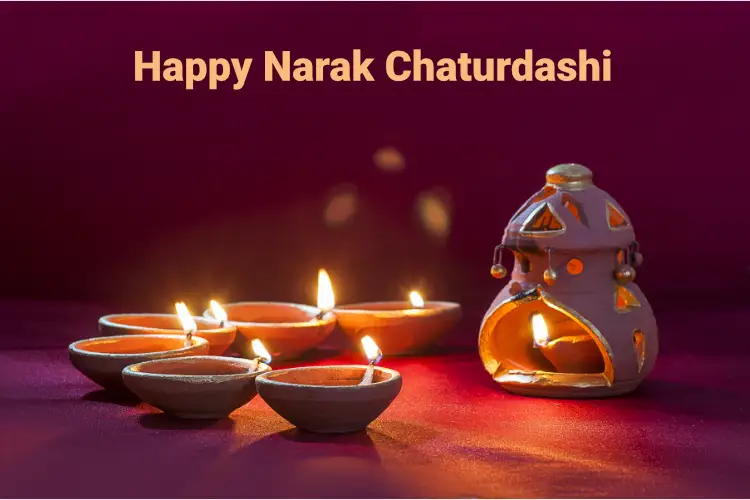
Naraka-Chaturdashi is day to abolish laziness and evil. It is also known as as Kali Chaudas, where Kali means dark (eternal) and Chaudas means fourteenth, which is celebrated on the 14th day of the dark half of Kartik month. On this day goddess Kali is worshipped and it is believed that on this day Kali killed the asura (demon) Narakasura.
Naraka Nivaran Chaturdashi known as Naraka Chaturdashi falls on the second day of the five-day-long festival of Diwali. The Hindu mythology narrates that demon Narakasura was killed on this day by Krishna and Kali.
People wake up early in the morning break any bitter fruit and apply the kumkum-oil paste, which is called ‘Ubtan’, on their foreheads and then take bath. The breaking of the fruit represents the head of the demon King, Narakasur and the kumkum-oil paste symbolizes the blood that Lord Krishna smeared on his forehead. In the state of Maharashtra, people take the traditional early baths after applying the paste of gram flour, fragrant powders and oil on their foreheads. As long as the ritual of bath takes place, deafening sound of crackers and fireworks could be heard so that the children enjoy bathing. At dusk, people start lighting Diyas and candles in and around their house to mark the celebration of Chhoti Diwali.
Vishwakarma Pooja
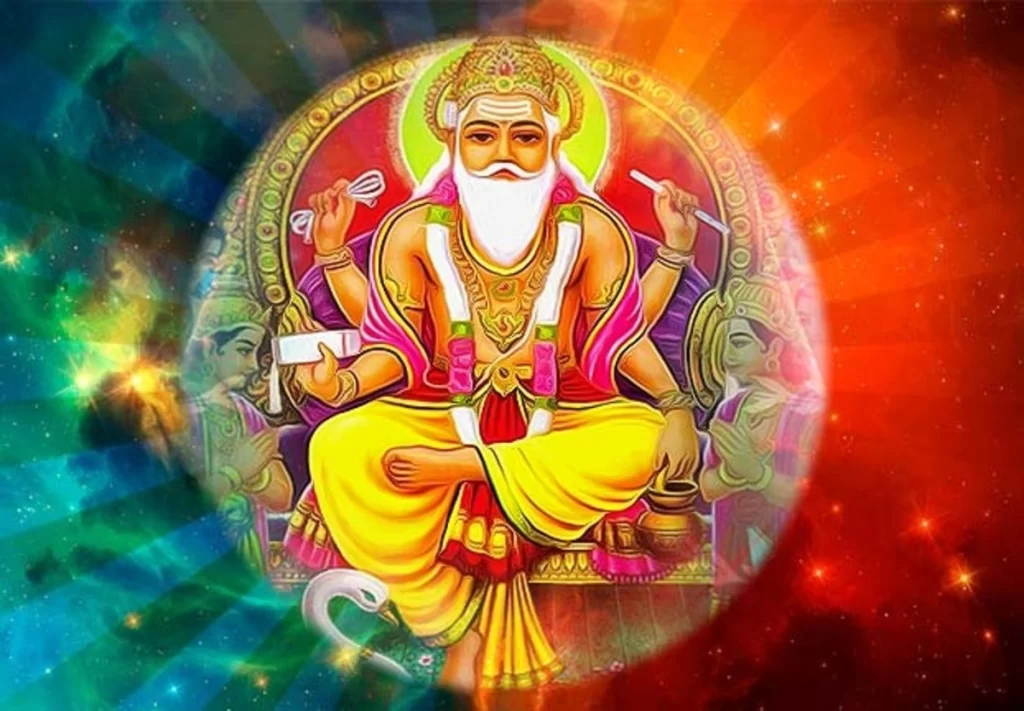
To acknowledge that lord Vishwakarma alone is the creator of all universe and the things within, and to offer worship and thankfulness to him on the Vishwakarma day, is what Vishwakarma Puja is all about. This is what lends the festival of Vishwakarma Puja its significance.
Lord Vishwakarma is described as the ultimate reality in the Rig Veda, whose name in Sanskrit means “All Accomplishing”, and who is believed by the Hindus to be the “Principal Universal Architect” who gave form to the celestial architecture of all that is in this universe with his own hands. And as a mark of reverence, he is worshipped as the patron of all the engineers, architects, artisans, craftsmen, weavers, mechanics, smiths, welders, industrial workers, and factory workers.
On the day of Vishwakarma Puja, the industries and factories observe a no-work day. During the day of the puja or a day before, colorful pandals are set up inside the premises of industries and factories after which the decorated idols and images of Lord Vishwakarma are brought inside the pandals and are established ritualistically. The entire unit – management, employees, and workers, along with their families come together to perform the puja. Even the tools, particular to each person’s profession, are worshipped in the name of Lord Vishwakarma but aren’t put to use until the next day. Thereafter, Prasad (offerings) is distributed among everyone, post which everybody sits together for lunch.
Goverdhan Puja
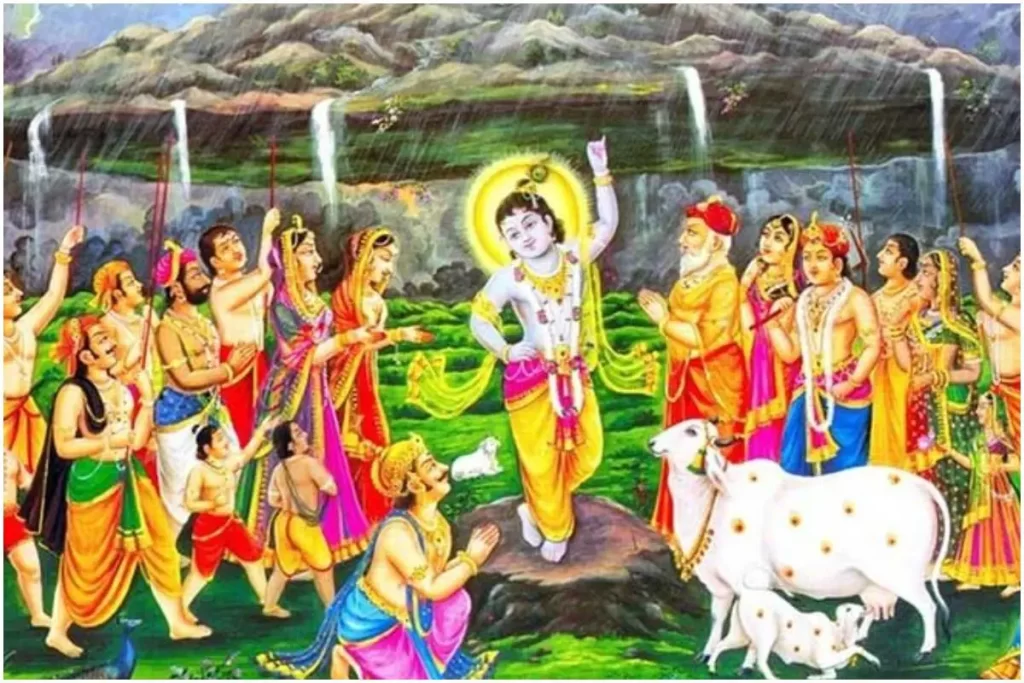
Govardhan Puja, also called Annakut (meaning a heap of grain) [clarification needed], is celebrated as the day Krishna defeated Indra by lifting the Govardhan hill. It is the fourth day of Deepawali (Diwali), the Hindu festival of lights. The day is celebrated on the first lunar day of Shukla Paksha (bright fortnight) in the Hindu calendar month of Kartik.
According to legends, Lord Krishna taught people to worship the Supreme Controller of nature, God, specifically Govardhan, as Govardhan is a manifestation of Krishna, and to stop worshiping the God of Rains, Lord Indra. For Annakut a mountain of food is decorated symbolizing Govardhan mountain said to be lifted by Lord Krishna to save the people from the wrath of Lord Indra, the demigod in charge of rain. This pooja is performed with great zeal and enthusiasm and in the states of Punjab, Haryana, Uttar Pradesh and Bihar. In Haryana, there is a tradition of building cow dung hillocks, which symbolize the Mount Govardhan, the mountain which was once lifted by Lord Krishna. After making such hillocks people decorate them with flowers and then worship them. They move in a circle all round the cow dung hillocks and offer prayers to Lord Govardhan.
Kartik Shukla Pratipada covering 3.5 Praharas is considered as the best Muhurat for Govardhan Puja. If the same situation continues for two days then second day is considered the day of celebration of this Puja but if the above situation is missing from both days then also Govardhan Puja is observed on Secon day only.
Bhaiya Dooj
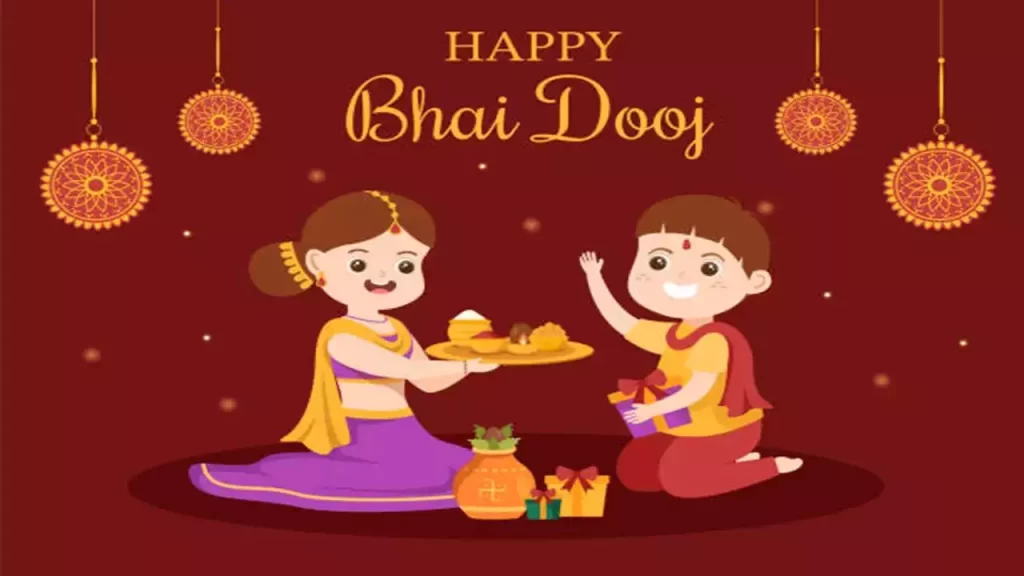
Diwali, the festival of lights, is a five day long celebration. The fifth or the last day of Diwali is Bhaiya Dooj, popularly known as Bhai Dooj. Bhai Dooj falls on the second day after the new moon. And it is a day to pray for the long life of one’s brother, who is referred to as “bhayya or bhai”.This festival marks the love between sisters and brothers, and is celebrated to strengthen the bond of care and affection between the two. Through the means of this festival, sisters commemorate their brothers with an auspicious tilak or a vermilion mark on their foreheads. In return, brothers give gifts to their sisters.
Bhaiya Dooj is celebrated on Kartik Krishna Dwitiya falling at Aprahan. If Kartik Krishna Dwitiya falls on two days and falls or does not fall during Aprahan then it is celebrated on second day otherwise on first day.
So traditionally, all brothers visit their sisters on this day and give them gifts. Sisters too, pray for their brothers’ long life and good health, and general well-being.
Chhath Puja
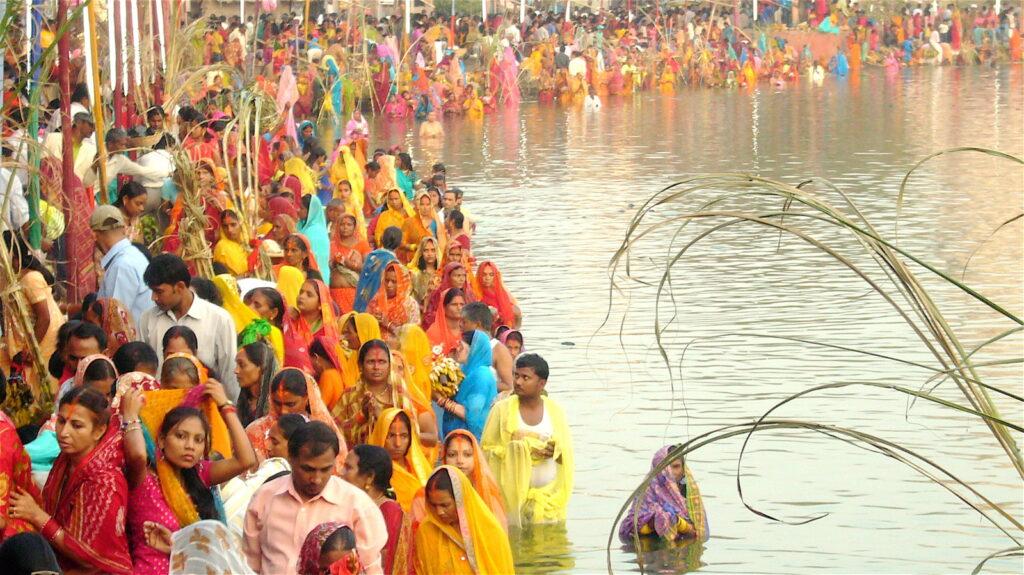
Chhath Puja, also known as Surya Shashti, is a popular Hindu festival celebrated in the northern regions of the India. These regions include Bihar and Uttar Pradesh. Other places where Chhath Puja is observed are Chhattisgarh, Chandigarh, Gujarat, Delhi, Mumbai, Nepal and Mauritius. Chhath is dedicated to Sun God which people believe sustains life on earth. Chhath Puja is also performed to seek blessings from the Sun God to promote prosperity and progress.
The origin of Chhath Puja dates back to Vedic times, as Vedic texts contains rituals associated with the worshipping of Sun. It is also believed that Draupadi, from the epic Mahabharata, used to perform similar rituals. Some people also believed that Chhath Puja was started by Son of Surya, Karna from Mahabharata. Chhath Puja is not only religiously significant, but also has several mental and physical benefits. Physically, the practice of Chhath facilitates in improving the immunity of the devotee. It is also believed that light rays emitted by sun are quite beneficial for the normal maintenance of the body. Being antiseptic in nature, the safe radiations from sun can help in curing fungal and bacterial skin infections. Sunlight received during Chhath provide energy that when get combined with blood streams enhances the performance of white blood cells, which further leads to improving fighting power of blood.
It is also believed that sunlight has significant effect the glands and helps in proper secretion of body hormones. The solar energy received from sunlight also meets the energy requirements of the body. The practice of Chhath also helps in providing a state of mental calmness. The regularized pranic flow of air during Chhath can help in reducing the frequency of anger, jealously and other negative emotions. The whole process of Chhath Puja leads to detoxification of the body and mind. Detoxification further enhances the energy levels in the body. The increased energy and immunity system serves in fighting the harmful toxins in the body. Some people believe that the Chhath process can improve eye sight, enhance the appearance of skin, and facilitate in slowing the ageing process. The devotees who sincerely and patiently practice the rituals of Chhath Puja are benefited by several psychic powers such as intuition, healing and telepathy. So, the next time when Chhath Puja comes, observe the fast and follow the rituals religiously and note that you would be benefited in more ways than one!
The festival falls in the month of October or November. The traditional rituals followed by people are quite strenuous in nature and are observed for a period of four days. The customs associated with Chhath Puja include holy bathing, fasting and refraining from even drinking water. It also includes rigorous physical customs like standing in water for extended periods, and offering prayer and Prasad during the sun rise and sunset.
Don’t have food during 24 hours of fasting stand in water and offer Arghya to Sun. In the river people light lots of lamps in beautiful rows. They chant Bhajans of Lord Sun and Devi Shashti. They read Chhat Puja Vrata Katha also.
Gopashtami

Cows are considered to be the soul of Hindu culture. They are pure and revered and are worshipped in India just like any other Hindu god and scriptures. It is believed that all the gods and goddess reside inside a cow, and thus, hold a special place in Hindu culture. According to the Hindu scriptures, cows are the mother of all species and every Hindu possess a respect for her. Cow is considered to be the owner of the divine qualities and is similar to goddess earth. Special pujas and saatsangs are organized in the evening inI temples around the country.
On this day devotees bathe and clean the cows early in the morning. There is a tradition of decorating and worshipping cows along with their calf on this day. Cows are worshipped in the morning with incense, flowers, roli, jaggery, fragrance, clothes, rice and water followed by performing the aarti. Many people give gifts to the herders a well. By doing all this devotee gets a prosperous and a happy life. As per the legend, Lord Krishna communicated his desire of herding the cows to his mother. As per his wish, Krishna’s mother went to saint Shandilya and asked him about the auspicious time to begin the work. The auspicious day as told by the saint, was Gopashtami. The innocent child worships and offers his prayers to the cows before commencing his new task.
Dev Prabodhini Ekadashi

It marks the end of the four-month period of Chaturmas, when god Vishnu is believed to sleep. It is believed that Vishnu sleeps on Shayani Ekadashi and wakes on Prabodhini Ekadashi, thus giving this day the name “Prabodhini Ekadashi”. It is strongly believed that by observing this Ekadasi, all the sins committed in passed life are washed away and the observer of this ‘Vrat’ gets the path to liberation (Moksha).Utthana Ekadasi, which falls in the Kartik month, is considered highly auspicious by Lord Vishnu devotees. Staunch Vishnu devotees observe a rigid fast on the day by skipping food and staying awake during night. Majority of the people take one meal mostly in the evening and visit the temples and other shrines dedicated to Lord Vishnu.
This Ekadashi, which occurs during the light fortnight of the month of Kartika, is much more purifying than a bath in the ocean or a sacred place.This divine Ekadasi is more powerful in nullifying sins than one thousand Ashvamedha sacrifices and one hundred Rajasuya sacrifices.” Lord Brahma continued, If a person eats once at noon on Ekadasi, the sins of his previous birth are washed away, if he eats supper, the sins acquired during his previous two births are nullified and if he fasts completely, the sins accumulated during his pervious seven births are erased.The sins accumulated over a thousand previous births are nullified completely if the devotee remains awake throughout Ekadasi night besides the fasting vrat.Even if one forefathers were implicated in many sins and are suffering in hell, they still attain beautifully ornamented spiritual bodies and happily go to Vishnu’s abode .
One, who worships the Tulasi-devi in this period, achieves ultimate happiness in the higher world, since there are roots and subroots growing from a mature tulasi plant.
On this day Gods come out of their sleep. Dev Prabodhini Ekadashi is celebrated on Kartik Shukla Ekadashi. For this Ekadashi connected with Dwadashi is taken. If Dwadashi disappears then fast is observed on Ekadashi connected with Dashami. If Ekadashi falls on two days then it is celebrated on the second day but if Dwadashi disappears then it is observed on first day only. If Ekadashi disappears then on first day and in case of extension of Dwadashi with disappearance of Ekadashi it is celebrated on second day.
A fast is observed on Prabodhini Ekadashi and the ritual marriage of the Tulsi plant is performed with god Vishnu, who is regarded as the husband of Tulsi. This ritual marriage is known as Tulsi Vivah and may be conducted on the next day of Prabodhini Ekadashi instead of Prabodhini Ekadashi itself.
Prabodhini Ekadashi is considered as an important Ekadashi in the Swaminarayan sect. The day commemorates the diksha, or religious initiation, of Swaminarayan by his guru Ramanand Swami on October 28, 1800. The day also commemorates the passing of authority by Ramanand Swami to Swaminarayan on November 16, 1801. Swaminarayan followers observe a waterless fast and offer an offering of fresh vegetables to the deities
Tulsi Vivah

Holy basil (tulsi) is the symbol of spiritual purity (sattvikta). The marriage of tulsi with Shrikrushna means that ‘God likes purity as a quality.’ The symbol of this is Shrikrushna wearing the necklace of Vaijayanti beads.
The meaning of the word marriage is the merging and oneness of the embodied soul (jiva) and God (Shiva).Tulsi Vivah is an important ritual performed in Kartik month in traditional Hindu calendar. Tulsi Vivah festival is the wedding of Tulsi plant to Lord Vishnu. Tulsi Vivah is performed by some communities on the Ekadasi day after Amavasi (new moon) in Kartik month and by some communities on the Dev Diwali day or the full moon day in Kartik Month.
Tulsi Vivah is an age-old tradition and is mentioned in the Padma Purana and other ancient scriptures. Tulsi, or the Holy Basil, is the sacred plant of the Hindus and symbolizes purity and is famous for its medicinal properties.
Legend has it that a king named Jalandhar got a boon that he will remain immortal as long as his wife Vrinda is chaste (Pati Vrat). This made King Jalandhar arrogant and he declared war on other kings, demi gods and started tormenting innocent people.
Prayer to be made: ‘Hey Shrikrushna, Hey tulsi Devi, the energy that I imbibe from you today, let it be used for the protection of Dharma and nation. Let my warrior attitude (kshatravrutti) be activated all the time. Let me not be depressed during bad times and let my faith and devotion unto God be consistent.’
Uses of tulsi: Tulsi being more spiritually pure (sattvik) God’s energy is attracted to it to a greater extent. Putting tulsi leaves in drinking water makes it spiritually pure (sattvik) and Energy (Shakti) is released into it. Through this water God’s Energy becomes active in every part of the jiva (embodied soul).
Baikuntha Chaturdashi

Vaikuntha Chaturdashi is a Hindu holy day, which is observed on chaturdashi, the 14th lunar day of the waxing moon fortnight (shukla paksha) of the Hindu month of Kartik (November–December). The day is sacred to the deities Vishnu and Shiva. They are worshipped individually or together in different temples in Varanasi, Rishikesh, Gaya and Maharashtra.
The holy day Vaikuntha Chaturdashi is also observed in Maharashtra by the Marathas as per the custom set by Shivaji and his mother Jijabai for this occasion and by the Gaud Saraswat Brahmins, though in a slightly different format.
Devotees of Vishnu offer the god a thousand lotuses while reciting the Vishnu sahasranama, the thousand names of Vishnu. The Vishnupada Temple, which is believed to have footprints of Vishnu, celebrates its main temple festival in this period. The festival is also celebrated as kartik snan (bathing in a river or stream during the kaartik maas) by Vishnu devotees. In Rishikesh, this day is observed as Deep Daan Mahotsav to mark the occasion of Vishnu waking up, out of his deep sleep. As a mark of environmental awareness, the deeps or lamps are made of flour (which would disintegrate in water) instead of burnt earthen lamps. The lighted lamps are floated in the holy Ganges River in the evening. This is accompanied by several cultural festivities.
The Grishneshwar temple of Shiva, Vishnu is offered Bael leaves and Shiva is offered Tulsi leaves. It is considered to portray the union of Vishnu and Shiva. In the Tilbhandeshvar temple in Nashik, the 2 feet (0.61 m) linga – aniconic form of Shiva – is dressed up in finery and a silver mask, as Ardhanarishvara, the half-male, half-female form of Shiva. Thousands of people worship the Tilbhandeshvar and Shiva Kampaleshvar temples in Nashik. The festival is one of the three important festivals of these temples.
Another observance is by celebrating avail bhojan (means a dinner) taken under the Phyllanthus emblica tree (Indian gooseberry).
It is also prominently celebrated in Vishnu temples like SriRanga (Tamil Nadu), Tirupati Srinivasa temple (Andra Pradesh), Udupi Sri Krishna Mutt (Karnataka) and many more.
Kartik Purnima

It is said that Lord Shiva and Lord Vishnu come to visit Earth during Kartik month. Hence, worshiping them on this day is considered highly fruitful. Devotees visit temples, take holy bath and light lamps. It is also known as Dev Diwali (Diwali of the Gods) and Tripuri Purnima. As per the name this holy month is dedicated to Lord Kartikeya.
Tripuri Purnima – It marks the victory of Lord Shiva over demons Tripuri. Hence this day is also known as Tripurari Purnima.It is one of the most potential days for pleasing lord Shiva.
Lord Vishnu appeared as Matsya (fish) avatar on this day.It is also considered as birthday of Vrinda and the last day to perform the ‘Tulsi Vivah’.
Guru Nanak Jayanti – Guru Nanak ji was born on Kartik Purnima in 1469 AD. Hence it is a special day for Sikh devotees.Kartik Poornima is very significant in Jainism. People visit religious places and worship Lord Mahavira.
It is also celebrated as Deva-Diwali or Deva Deepawali – the festival of lights of the gods.
Kartik purnima is a day to get liberation and free yourself from sins.Puja worship, fast and donate done on this day gives results equivalent to that of Ashwamedha yagya.
Kartik Purnima bath is taken on Kartik Purnima falling at sun rise. If Kartik Purnima falls on two days and falls or does not fall at Sun Rise then it is celebrated on the first day.
On this day the observer should worship the 6 Kruthikas, Shiva, Sambhuti, Santati etc at time of moonrise. One who ceremoniously donates a buffalo at night, is blessed and achieves highest state of celibacy (Shivapad). One should observe a fast on this day and should contemplate upon God.
